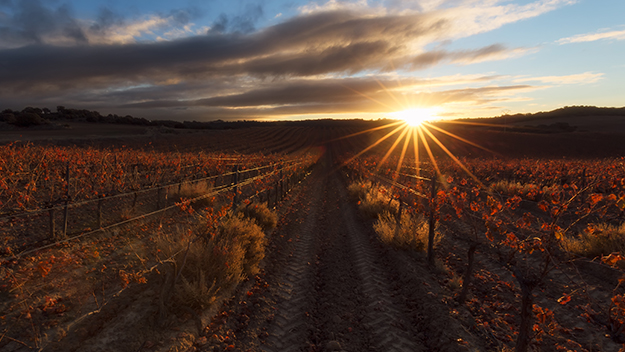Find your winery or vineyard
1 Wineries and Vineyards for sale in DOCs Sicily
Infographic of the Denomination of Origin

Change to imperial units (ft2, ac, °F)Change to international units (m2, h, °C)
DOCs Sicily
Sicily still preserves some ancient planting systems, historical winemaking and ageing methods, and its territory is divided into small appellations.
In western Sicily, the volcanic hills are less dramatic individually but just as influential for the soil types. In the province of Trapani, where half of the region's vineyards are concentrated, the soils are reddish, due to the abundance of iron, and mineral, and are home to DOC Delia Nivolelli (with some memorable syrah-based crianza wines), DOC Erice, DOC Alcamo (realm of excellent single-varietal catarratto whites) and, of course, DOC Marsala. Marsala wines can be produced in almost all the province of Trapani, although the best and most historic wineries are located in the city that gives its name to the appellation. The DOC was created in 1969. The production legislation classifies marsala on the basis of three elements: colour, sugar content, length of ageing and consequent alcoholic strength. The combination of these factors gives rise to the various types of marsala, and it is also important to specify the difference between virgin marsala and marsalas considered ‘liqueur’, i.e. fino (younger) and superior marsala with more ageing. The white varieties authorised by law are grillo, catarratto, inzolia and damaschino, while the red varieties are pignatello, nero d'Avola and nerello mascalese, which can be added up to a maximum of 30% to the above-mentioned whites.
In western Sicily there are also other important appellations. The DOC Monreale extends along the hills of the inland of the province of Palermo and offers elegant and perfumed inzolia wines of discreet freshness. The most significant DOC of the Belice valley is Contessa Entellina, bordering the province of Agrigento, known for its modern reds, blends of nero d'Avola and international grapes such as cabernet sauvignon. Of excellent quality, with a saline background acquired from the sea and the minerality of the soils, are the DOC Menfi whites, some based on inzolia, others on chardonnay and even some magnificent interpretations of fiano. Other DOCs in the area include Salaparuta, Santa Margherita di Belice and Sciacca. Also of note is the small Sambuca di Sicilia DOC, whose wines should not be confused with Sambuca, the potent aniseed liqueur.
The DOC Moscatel and Passito de Pantelleria, this volcanic island in the southwest of the island of Sicily, deserves to be treated separately. The DO was recognised in 1971, but underwent changes in 2001. On soils furrowed by winds and craters, or on steep terraces overlooking the sea, Zibibbo is grown on old vines planted in gobelet vines, many of which are free-standing. Zibibbo is a slightly aromatic moscato variety that is vinified as a dry white wine, with a strong iodine minerality, and also as a sweet white wine, either late harvested or with sultanas, wines which in this case fall under the appellation of Passito di Pantelleria, a UNESCO World Heritage Site. At the mercy of the wind and the sun's rays, the bunches of grapes are dried. After ageing, which can take place in steel or wood and can last up to ten years, the result is a wine that is sometimes moderately oxidised and decidedly saline, with hints of dried apricots and a great concentration of aromas and flavours, the indisputable hallmarks of one of the flagships of Italian wine. Passito and Moscato are excellent dessert wines. It is a wine renowned for its high quality, which comes in various forms. These include Moscato di Pantelleria, Passito di Pantelleria, Pantelleria Moscato licoroso, Pantelleria Moscato dorato, Pantelleria Passito licoroso and Pantelleria Zibibbo dolce.
In the eastern part of the island, the appellations are more limited, but at the same time more representative. The most noble area is undoubtedly the one linked to Etna DOC: volcanic sands, ancient conduction systems and steep rocks offer one of the most heroic viticultures in the world, with steep terraces and vineyards planted mainly in goblet, free-standing vines. Centuries-old vines and mythical vineyards that offer, from altitudes of over a thousand metres, some of the most subtle, smooth and elegant reds in the world. The merit is due to one variety, the Nerello Mascalese. It can be blended with small amounts of nerello cappuccio, a grape with more colour and a softer, spicy character. The great thermal contrasts of the area confer elegance both to the reds, which prevail on the northern slope of the volcano, and to the whites, which are mainly concentrated on the southern slope. This is the realm of the carricante, a concentrate of minerality and flavour with intense acidity.
The same Etna red grapes are the protagonists of the excellent DOC appellations of the province of Messina: Faro and Mamertino, one of the oldest wine regions in the world, where it is common to blend nerello with nocera, a grape native to the Milazzo area. Nerello reds are also representative of the volcanic Aeolian islands, although between Salina and Lipari the typical local Malvasia stands out, vinified both dry, with an intense minerality, and in a dried version, passita, under the DOC Malvasia delle Lipari, saline and characterised by aromas of dried apricots with sulphurous notes. The local reds are based on corinto nero. The origin of the word ‘malvasia’, according to a Christian legend, comes from the time of the Muslim domination which tells how a peasant carrying an amphora full of muscatel replied to a ruler who was carrying ‘juice of malvasia’, begging God for a miracle, and so it happened that when the ruler drank it, he showed an expression of disgust. In 1973, the denomination of origin (DO) was established for the Lipari malvasia. It is considered one of the oldest and most prized wines of Sicily. It is made from 95 % of the Lipari malvasia variety and a small 5 % of corinto nero. The three varieties are: Malvasia delle Lipari, Malvasia delle Lipari passito and Malvasia delle Lipari licorosa.
South of Catania, the Iblei Mountains take their place in the wine of south-eastern Sicily. On their lower slopes and the coastal plains below them, the DOCs of Syracuse, Noto, Eloro and Vittoria. The province of Syracuse is the birthplace of the nero d'Avola but is best known for its sweet wines made from raisined white moscato grapes: the DOCs of Moscato di Noto and Moscato di Syracuse are home to some fascinating wines with a traditional flavour and a vegetal and balsamic fragrance.
The south-east of the island is also the land of frappato, another of the defining varieties, especially in the Vittoria area: a red grape that exhibits a delicious fruity and mineral fragrance together with an elegant and delicate structure. Frappato is usually vinified as a single varietal but also blended with nero d'Avola: in this case, giving life to what is the only DOCG on the island, the DOCG Cerasuolo di Vittoria. This is the most classic and historic area at an altitude of up to 500 metres.
The origins of frappato are also uncertain, although it seems to date back to Vittoria, in the province of Ragusa, where it has been cultivated since the 17th century. For a time it was thought to have come from Spain. As far as we know, the first person to mention this variety is Sestini in 1812. This was followed by Salvatore D'Agostino and Paolo Balsamo, who spoke of the blend with nero d'Avola. At the end of the 19th century it was the main variety in the area because in Vittoria it found its perfect habitat thanks to the sandy soils, the ‘terra rossa’ and the warm climate. And the blend with the nero d'Avola was perfect because it grew in cooler and more humid soils, as it also works with the nerello mascalese.
There are just over 800 hectares. It is found in the DOCG Cerasuolo di Vittoria and in the provinces of Ragusa, Catania, and Caltanissetta in the south-eastern part of Sicily. Here, when blended, it is 50-70% nero d'Avola and 30-50% frappato. It should be noted that this is one of the Sicilian areas where organic and organic wines are becoming more and more common. Frappato also forms part of other appellations such as Alcamo, Eloro, Erice or Vittoria and in the Trapani area. The name comes from ‘fruity’ because of its splendid aromatic definition, so fruity and spicy with a marked acidity. It is known as the Sicilian pinot noir.
WINES AND WINERIES
Sicilian sweet wines make up about 64% of all DO wines produced in Sicily, but considering that they represent only 3% of Sicilian wine production, this type of wine is considered a product of great historical and cultural value.
Wine is part of history and it would not be fair to forget the pioneers of red wine on the island such as Luigi Tasca, the Planeta family, the Rallo family, Duca di Salaparuta, Marco de Bartoli, Feudo Monton, without forgetting the fundamental arrival of the oenologist Giacomo Tachis, one of the fathers of Sassicaia, who was a basic piece in the development of the new bets.
Wineries that produce wines with Nero d'Avola in the different areas of Sicily. In the centre and west are Duca di Salaparuta, Cusumano, Feudo Montoni, Tasca d'Almerita, Donnafugata, Firriato, Valdibella, Morgante, Principe di Butera-Zonin, Rapitalà. In the east are Gulfi, Occhipinti, Planeta, Valle dell'Acate, Cos, Savino, Riofavara.
Wineries that produce wines with frappato. In the east are Il Frappato, Cos, Valle dell'Acate (Il Frappato and Cerasuolo di Vittoria with 60% Nero d'Avola and 40% frappato), Vittoria, Cali (Bianca di Luna a frappato vinified in white and Mandragola Vittoria), Frappato Carolina Marengo.
Discover more wineries and vineyards for sale in these wine regions in Islands
Subscribe to our mailing list to receive news about wineries and vineyards.







